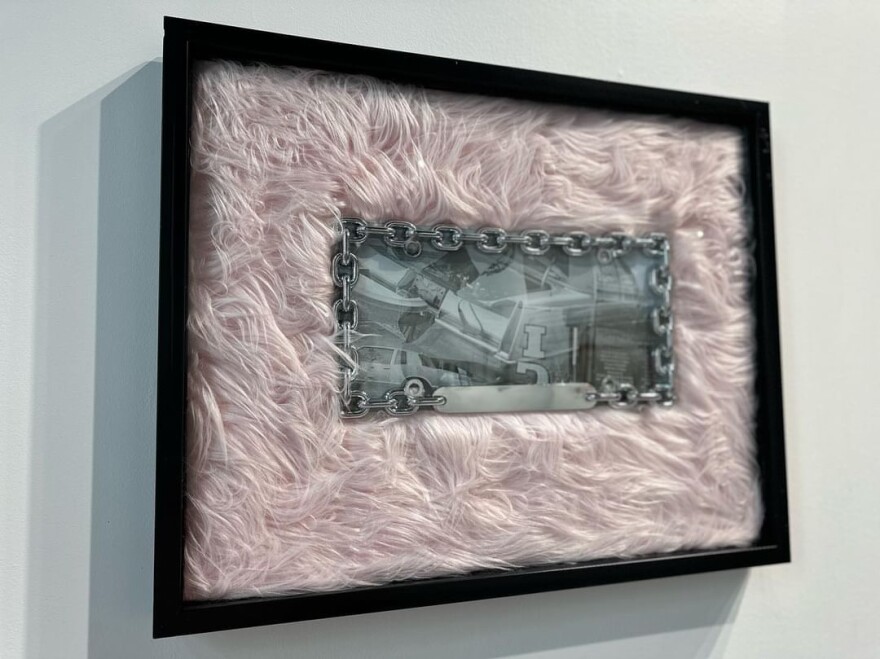Lowriders and oversize flannel button-downs, gold jewelry and the Mexican flag.
Two North Texas multimedia artists are filtering symbols of Chicano culture through their own lenses to reflect on their experiences growing up first-generation Mexican American. Their work also touches on larger themes of religion, adolescence and identity.
“When you’re first-generation, I feel like you’re always stuck and you’re fighting between two cultures,” said Adrian Garcia Mendez, founder of Her.Manos Photography. “You want to put them together but the people from both sides try to pull them back. You’re the rope and you want to bring them together.”
Martha Rincón’s, known as Thrive, three-photo series titled “Eslabón por Eslabón,” or “Chain to Chain,” is being showcased at 400 H Gallery until November. The series consists of three double-exposure photographs of lowriders taken at a car show in 2020. All three photographs are printed on makeshift license plates and layered on top of a pink faux fur background.
“That was a time when I really started capturing lowrider culture, so when I got asked to be a part of this event, I was like, ‘I kind of want to bring that back, like a little ode to the beginning of me,’ ” Rincón said.
And it’s not just Rincón and Garcia Mendez; Chicano culture is having a moment. Over the past few years, there’s been renewed interest by mainstream arts institutions in showcasing the local arts and culture of Mexican Americans.
Sarah Ayala
Back in 2022, the Dallas Museum of Art hosted a lowrider event for its Drifting on a Memory mural. Dallas artist Lokey Calderon and East L.A archivist and artist Guadalupe Rosales presented their immersive 153-foot mural of a pinstriped lowrider in the museum’s concourse. The entire concourse was designed to make visitors feel like they were inside a lowrider. Dallas lowrider clubs were invited to show off their lowriders in the front and back of the building.
Rincón was there, too. She designed an airbrushed backdrop and set it up by the museum’s main entrance and took glam photos of attendees.
Martha Rincón
“I feel like that was a big moment in Latino culture in Dallas,” Rincón said. “When have you ever seen so many Latinos and lowriders at the DMA? It was so important and I’m very, very grateful to have been a part of that.”
Growing up in the Webb Chapel neighborhood of Dallas, Rincón remembers going to flea markets with her family. When she was a teenager, she bought her first camera, a Canon AE-1, at a vintage shop that used to be in Deep Ellum and began shooting photographs of buildings and architecture. After realizing she enjoyed photographing her friends more, she started taking portraits, incorporating bits of her family memories into her photo shoots to make them more personal.
Martha Rincón
“I have a picture of a girl, one of my models, at a bazaar, and that’s childhood for me.” Rincón said. “Every Sunday, my family and I would go to either indoor swap meets or flea markets. It was part of my childhood, like a family ritual type of thing.”
Garcia Mendez, an Oak Cliff native, always messed with cameras. He filmed videos with his flip phone, sending them to his friends just for fun. Three years ago, he wanted to expand his craft so he picked up a film camera. He began photographing old, abandoned buildings covered in graffiti and street art. Later, he transitioned to photographing lowriders.
Adrian Garcia Mendez
“These are just things I saw growing up,” Garcia Mendez said.
Both Garcia Mendez and Ricon showcased their work in exhibitions this month. Photos by Garcia Mendez were recently featured in “Euphoria,” a photography show at 500X Gallery in Dallas that showcased photographs and installations that blurred the lines between “reality and the ethereal.” Garcia Mendez displayed six photos, including a self portrait titled Payaso Vaquero . In it, Garcia Mendez is dressed like a cowboy, but also sports a clown nose and big, puffy white Mickey Mouse-esque gloves.
“I always say I have to say a joke to tell the truth,” Garcia Mendez, who was known as the class clown as a child, said. “That’s why the payaso is always in my work and why I always see myself as the payaso.”
Adrian Garcia Mendez
While both artists’ works represent their backgrounds, they hope their art can send a message to larger audiences. Garcia Mendez said he wants his photography and short films to help people value and learn more about his Hispanic culture, instead of stereotyping. Similarly, Rincón said her work comes from the pride she has with her cultural roots, but she wants others to be able to connect with it.
“If other people can resonate with it, then I’m already winning,” she said.
“Eslabón por Eslabón” runs until November at 400 Houston Street Gallery & Studio in Fort Worth. Find more information here.
Arts Access is an arts journalism collaboration powered by The Dallas Morning News and KERA.
This community-funded journalism initiative is funded by the Better Together Fund, Carol & Don Glendenning, City of Dallas OAC, Communities Foundation of Texas, The Dallas Foundation, Eugene McDermott Foundation, James & Gayle Halperin Foundation, Jennifer & Peter Altabef and The Meadows Foundation. The News and KERA retain full editorial control of Arts Access’ journalism.
